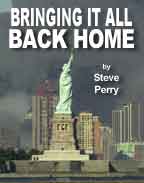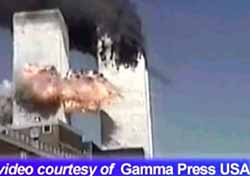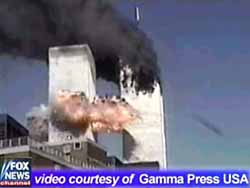Half-told stories and lingering questions already abound in the flurry of Bloody Tuesday coverage.
by Steve Perry
POSTED SEPTEMBER 17, 2001--
Everything is different this time, as we have been reminded ceaselessly over the past few days. A new kind of guerrilla terror has come to our shores, engendering a new kind of war to be fought in the  months and possibly years to come. It bears noting that one thing, at least, has changed for the better. Thanks in large part to the Internet, it now possible for journalists and the citizenry at large (those with the time and inclination, anyway, which is to say regrettably few) to sample a broader range of reportage and opinion from the U.S. and elsewhere than in any past war or national emergency.
months and possibly years to come. It bears noting that one thing, at least, has changed for the better. Thanks in large part to the Internet, it now possible for journalists and the citizenry at large (those with the time and inclination, anyway, which is to say regrettably few) to sample a broader range of reportage and opinion from the U.S. and elsewhere than in any past war or national emergency.
I don’t mean to sound like one of those evangelizing e-democracy nerds. A certain measure of cynicism is invaluable in approaching the torrent of information now available at a keystroke. Most of what one finds on the Internet is hopelessly, uselessly redundant. What, after all, is the great virtue in being able to access a dozen major newspapers and networks in an age when the establishment media is more than ever speaking with one voice and perking its ears to the same masters’ commands? Still, the palette of information is undeniably richer now, not least because the pace of events and the nature of the Internet itself—a perpetual real-time news medium is a hungry beast—serve to loosen official control of news and conjecture. If you use your time judiciously, and make a point of attending to foreign news websites (a set of links appears at bottom) and the wire services as well as the usual major media suspects, you can learn more than your government ever wanted you to know about the drift of things.
What follows is a set of questions and conjectures about aspects of Bloody Tuesday and its aftermath that have received scant or dubious coverage—stories, or intimations of stories, that turned up buried in other dispatches or surfaced briefly and then vanished. Quite possibly some of the sources I have relied on will prove mistaken or misleading in days to come; it is just as likely, however, that some will turn out to have disappeared from radar only because the managers of public information and opinion wished it so.
What was in that plume of dust and ash from the trade centers, and what long-range health risks does it pose?
Preliminary reports of air readings in Manhattan made worrisome mention of airborne poisons such as asbestos, lead, and dioxin, but officials hurried to offer reassurance. Under the headline “Monitors Say Health Risk From Smoke Is Very Small,” Friday’s New York Times reported that downwind air samples—mainly taken in Brooklyn—showed no cause for concern. And press accounts all through the week emphasized that the documented dangers of asbestos in particular were mostly related to long-term exposure. That there had surely never been such a concentrated release of asbestos and other toxins at one time in one place was a point that passed without comment.
The sanguine pronouncements of the experts called to mind the U.S. government’s repeated assurances in the 1950s that the fallout from nuclear tests in the American West posed no threat to public health—the difference being that this time the situation was far more desperate and intractable. Under no circumstances could New Yorkers in general or the clean-up workers on-site be told that they had no business breathing the air. Across the border, meanwhile, Saturday’s Toronto Globe and Mail offered a terrifying assessment. I’ll quote from it here, but you ought to read the story for yourself:
“The smouldering rubble is a vast aggregate of metal, concrete and glass, mixed with slowly burning paints, solvents, lubricants, insulation, wiring, office furniture, vehicles and decomposing bodies, which pose a number of risks, including lung problems and communicable diseases.
“The two 110-storey buildings were full of every imaginable type of building material and office equipment, much of it ignited by burning jet fuel and some of it burning slowly for days. …
“ ‘PVC is the plastic sheathing on electrical wiring. When it burns, 75 known carcinogens are released,’ said Catherine Coppin of MLT Mobile Lung Testing Ltd. in Vancouver.
“ ‘That’s just one individual product, and there were thousands of them burning.’”
What really brought down United Flight 93 in rural Pennsylvania?
In the very early going it seemed likely that U.S. fighter jets had shot it down en route to Washington D.C. Then came word that a group of passengers, upon hearing via cell phone about the other suicide attacks, decided to take their chances storming the hijackers. The note of heroism thereby struck was the only bit of good news to emerge on Tuesday, and it quickly became the accepted version.
But if that was indeed how the plane wound up crashing short of its target, why were pieces of debris subsequently discovered up to eight miles from the crash site? This fact, little-mentioned but uncontested by official sources, suggests there was an explosion aboard the plane. In that event, two possibilities: Either the hijackers possessed a bomb of some kind or someone fired on it. The former is possible but unlikely, since none of the other planes seem to have contained bombs and because attempting to carry a bomb onboard is a decidedly riskier proposition than arming yourself with box-cutter blades. That leaves aircraft-on-aircraft fire. And on Thurday Reuters put out a wire story that began this way: “Federal investigators said on Thursday that they have not ruled out the possibility that United Airlines Flight 93 was shot down over Pennsylvania…” The Reuters piece went on to say that one passenger talking on his cell phone reported hearing an explosion.
And then no further word, at least none that I could find in national media. Friday’s Pittsburgh Post-Gazette featured a denial by NORAD that its fighters had shot the plane down, but that was the end of the matter. It’s a curious thing. Unlike the question of the air in Manhattan, there is no ostensible reason to stonewall here. If news surfaced that the Air Force did shoot down Flight 93, it would most likely bolster public confidence: At least then the government could claim it had done something effectual under the heat of attack. Perhaps the judgment is that the heroic tale of a passenger revolt is a rallying point; in any case, the curious and salient thing is how silent the media have been in the face of the physical evidence (debris scattered over eight miles?) and at least one on-the-record concession of the possibility by an FBI agent. It only proves how completely even a story of considerable prominence and undeniable import can vanish from under our noses when the right people want it to.
A footnote, incidentally, on the real-time military response to the attacks: Over the weekend rumors spread round the Internet that there was video footage of the second WTC crash which showed another plane, possibly a fighter jet, flying past the scene and veering away seconds after impact. On Sunday night Fox News aired the footage in question, and there is indeed another streaking object visible in the shot some time after the explosion at the south tower. (A handful of frames are reproduced below.) It’s impossible to tell from the grainy image what it is, but it clearly seems to be proceeding along a trajectory that would preclude its being crash debris. Did a military jet arrive on the scene too late to do anything? Here’s betting this matter, too, quickly falls off the table.






Did U.S. intelligence services fail to heed warnings of the pending attack?
The tales have spread thick and fast in major media and on Internet mail lists. An Iranian imprisoned in Germany phoned U.S. intelligence agencies repeatedly to warn of impending attack; bin Laden himself is said to have circulated a video three weeks ago in which he boasted of an imminent offensive; on Wednesday a Goldman, Sachs employee in Japan posted a message to a Gore Vidal fan list in which he claimed the company’s personnel were advised to stay away from U.S. government buildings on Tuesday. And so it goes, ad nauseam.
Against all this, one has to consider that such warnings are now a staple of business and government communications: background noise. Whether there was specific and credible intelligence regarding these particular attacks is another matter. American pols and intelligence apparatchiks are amply ready to point fingers in the interest of transferring blame or securing additional funding for future spy operations, but all this should be taken with a grain of salt, because what they most wish to convince the public, and themselves, is that what happened on Tuesday was foreseeable and preventable. That remains very much an open question.
What seems undeniable is that the CIA and other shadow agencies of the U.S. government now find themselves caught up short by the Cold War model of espionage on which most of their endeavors are modeled. (In the words of one characteristic press account published in the UK this weekend, “The CIA has failed to infiltrate Osama bin Laden's terrorist network because its men are not prepared to spend long periods without sex or go into any area where they might get diarrhea…”) In other words, they act as if geopolitical intrigue were still exclusively the white man’s burden. The supposition seems entirely sensible, but even if it’s so it doesn’t necessarily mean they can consistently penetrate the kinds of small-to-moderate scale guerrilla operations the U.S. now wishes to expunge.
Foreign press links:
www.globeandmail.com
www.telegraph.co.uk
www.independent.co.uk
www.thetimes.co.uk
www.jpost.com
www.newsdirectory.com
Steve Perry is a writer and critic. He lives in Minneapolis, where he was the editor of City Pages from 1989 to 1997.
Email: Steve Perry
More by Steve Perry:
Grumpy Old Archetypes: An Interview With James Hillman
The Seduction of Paul Wellstone
City Pages Archive